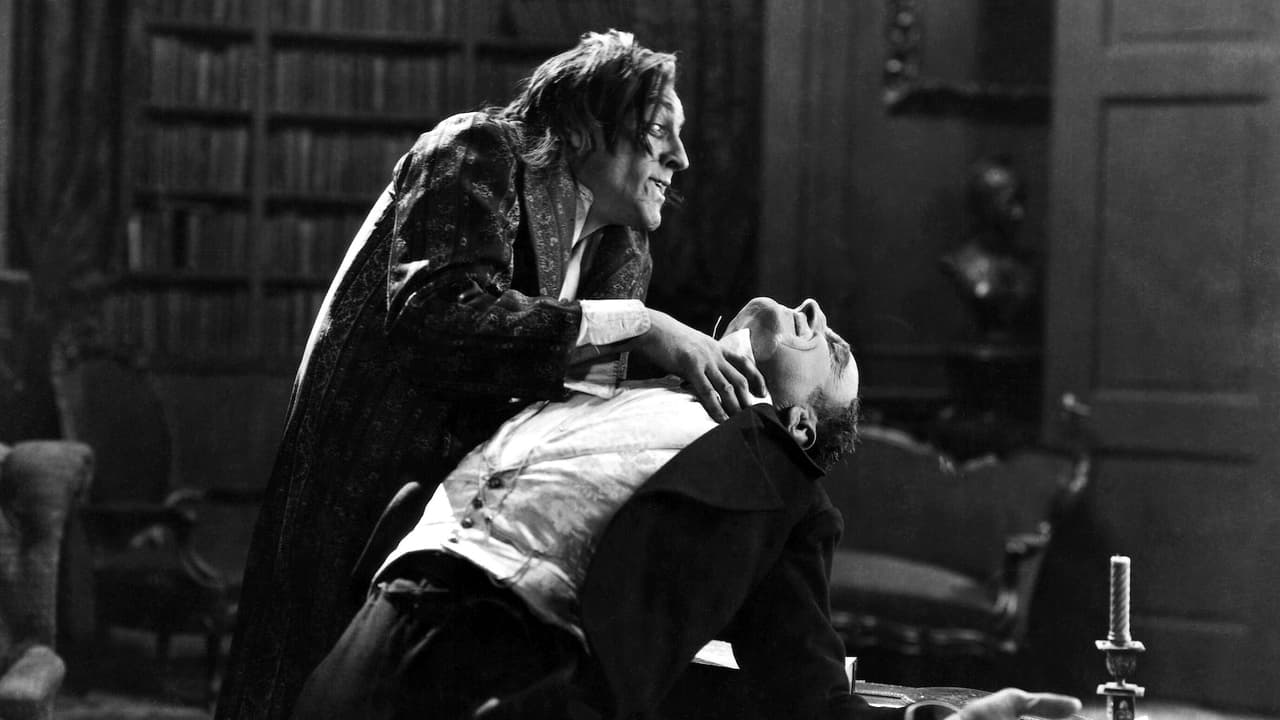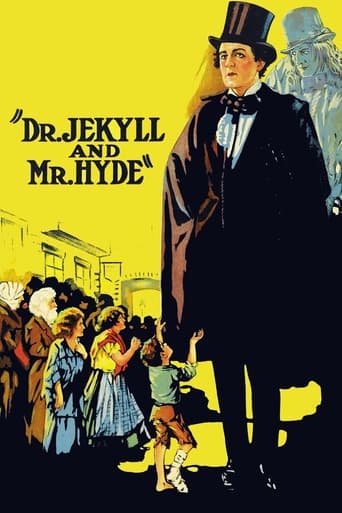

This is the third of 3 silent era versions of this movie I'm seeing--not counting "Dr. Pyckle and Mr. Pride" of course. The other two films, made in 1912 and 1913 were both relatively short, but this film directed by John S. Robertson runs at an hour and twenty two minutes, which in my opinion is a little too long. Some parts of this movie aren't really necessary--I'm not really sure what Miss Gina had to do with the rest of the action and other parts with Mr. Hyde seemed like padding. Then again, I suppose they overdid it a bit just to show off Hyde's physical appearance. As in the other versions, Jekyll here has a girlfriend. Only--and this is interesting--she is the daughter of Sir George Carew, the man who Jekyll later murders as Hyde. He is portrayed as a bad influence to Jekyll and a temptation. In the end, Jekyll can't resist and follows Carew. As a result, he turns into Hyde--and this Hyde here looks amazing, with straight black hair, long nails and fingers, and a lump on his head. The appearance of him is in fact very good and it does seem as though John Barrymore--the actor who played both Jekyll and Hyde--was two different people. Hyde starts then causing trouble and weakening Jekyll's ability to control him, and disastrous results occur.Mostly, the movie is very slow-moving and has some unnecessary parts--what Hyde had to do with two random ladies in a bar is beyond me. However, this is not to say there aren't some good moments: having Jekyll transform into Hyde in front of Carew before murdering him is a nice addition. The ending, also very interesting--Jekyll's girlfriend never actually knows the whole truth. It clearly strays from the novella quite a bit--but then, it improves the story too. Hyde is well portrayed and is probably the better version of all 3 of them.Padded certainly, but otherwise a good movie. Just watch the 49 minute version instead, if you can.
... View MoreDirector: John S. Robertson. Screenplay: Clara S. Beranger. Based on the 1886 novel The Strange Case of Dr Jekyll and Mr Hyde by Robert Louis Stevenson. Photography: Roy F. Overbaugh. Art director: Robert M. Haas. Set decorator: Charles O. Seessel. Producer: Adolph Zukor.A Paramount-Artcraft picture, copyright 18 March 1920 by Famous Players-Lasky Corp. New York opening at the Rivoli: 28 March 1920. 67 minutes. SYNOPSIS: Do-gooder Dr Jekyll is tempted by man-of-the-world Sir George Carew to explore the flesh-pots of licentiousness. However, not wanting his depravity to be traced home, he invents a drug which transforms him into the malevolent Edward Hyde.COMMENT: I take a keen interest in this one as I am a direct descendant of Robert Stevenson (the grandfather of RLS). RLS's short novels have always been an extremely popular subject with movie-makers. In fact, there are so many credited and uncredited versions of Dr Jekyll and Mr Hyde, it would take more than one full-length book to do them all justice. For example, less than a month after this one was released, Louis B. Mayer unveiled yet another movie adaptation, this time with Sheldon Lewis in the title role. However, despite the abundance of films on the ground, there are really only three versions that most people remember today: John Barrymore's, Fredric March's and Spencer Tracy's. This Barrymore incarnation was available (2004) in an extremely fine VHS restoration in the Republic Pictures Silent Classics home video series. Ton fact, the whole film is so meticulously tinted, it provokes gasps of wonder from people who are used to seeing washed-out snips from silent movies that completely fail to capture the original beauty and artistry of the cinematography. The interior sets have a reddish sepia glow that is almost three-dimensional in effect. Deep purple effectively serves for night exteriors, while green does duty for daytime sequences. Although it runs only a "B" picture length of 67 minutes, this "Dr Jekyll" does not run short of production values. Allied with the lustrous photography, are sets and costumes to likewise marvel at. As for the direction, it maintains a high level of competent artistry without descending to arty effects. No, Dr Jekyll only falls short in the acting division. A contemporary critique in The New York Times sets forth the problem very plainly. On the one hand, we have John Barrymore, whom the anonymous New York Times reviewer praises to the skies. On the other side of the equation, stand the rest of the cast, whom The Times man opines let the side down badly. A modern audience, however, is most likely to form the exactly opposite opinion. It's Barrymore's performance that's way over the top, the rest of the players who make valiant efforts to keep the movie on an even keel (with the exception of the poorly made-up Cecil Clovelly whose role is too small to take much notice of anyway). Brandon Hurst delivers a particularly subtle study of the tempter, while Martha Mansfield seems far more sensitive and refined than either the March version's Rose Hobart or the Tracy version's Lana Turner, while Nita Naldi (in a much briefer role) runs rings around Miriam Hopkins and edges close to Ingrid Bergman.Barrymore should have been ideal, but he seems wrong right from the word, "Go!" Admittedly, he does bring off quite a few effects rather well, but mostly he hams away with an obviously self-satisfied delight in his own posturing and the limelight.
... View MoreAlongside Sherlock Holmes and James Bond, Robert Louis Stevenson's novella The Strange Case of Dr. Jekyll and Mr. Hyde is a work that has spawned many screen adaptations, yet predates both, the first of which dating as far back as 1908. Widely considered one of, if not the best of the bunch, John S. Robertson's seminal 1920 proto-horror classic is mostly remembered for one thing above all others. Played by an endlessly captivating John Barrymore, the characters of Jekyll and more importantly Hyde, are brought into—or returned to—existence with contrasting shades of elegance and pure ham-fisted grotesque in a performance that many point to as Barrymore's first 80 minutes of brilliance. Relying on little to no makeup for some of Hyde's appearances, the actor merely uses his face as a means of creeping the hell out of you as he stares enigmatically through the lens with eyes watering with madness and depravity. Simply put, it's the stuff of nightmares and silent-horror gold.Outside of these murky, lusty, greasy scenes featuring Barrymore's crazed shuffle and psychotic debaucheries however, there's only a few other aspects of the film which draw quite the same amusement and/or repulsion. Overbaugh's photography does well in capturing said scenes, often sticking on Barrymore's close-ups for long periods of time, his face serving somewhat hauntingly as our only source of light in a sea of overwhelming shadow. There's also a great specials effects sequence involving a gargantuan spider crawling up the far-end of Jekyll's bed which, even now some 95 years later, is very strikingly uncomfortable to watch. Furthermore, set designs shake up the nihilistic, slimy pre- code undertones of the feature well enough, always maintaining a sense of darkness and gloom that pervades Jekyll's world, though perhaps not quite as convincing as Griffith's depiction of Victorian London in Broken Blossoms. Overall though, there's a sense that without Barrymore, there wouldn't be much left to pick at here. Perhaps it's a natural result of being all-too-familiar with the source material that the plot seems shallow and a bit lacklustre. But regardless of the reasoning, Robertson's version here is competent at best when John "the profile" Barrymore is either not present, or not being allowed to ham it up. It's more than worthy of a watch though, if only to enjoy the performance of its lead star. If you do, be sure to catch the newly restored blu-ray version released in 2004 which features a great Rodney Sauer score performed by the Mont Alto Motion Picture Orchestra that mirrors the feature's action superbly.
... View MoreNext to comedy, horror movies seem to hold their value best in the realm of silent cinema. Dark shadows, flickering lights, unintelligible conversations, and a pervading sense of time's unrelenting passage lend an uneasy quality of the macabre.That said, "Dr. Jekyll And Mr. Hyde," the pioneering U. S. horror film starring John Barrymore, still comes off as boring and frustrating, not to mention more than a bit hokey. It manages to take a fine story and flatten it out into a handful of striking images and a lot of waiting in-between.Jekyll (Barrymore) is a good doctor in a bad spot. Ridiculed by his friends for his upright ways, he decides to embrace his own dark side by means of an experiment, with himself as the lab rat. He discovers a chemical that transforms him into a brute named Hyde, and runs wild in London's poorer quarters. But getting back to Jekyll proves difficult.There are a lot of allowances that have to be made in watching this century-old film, beginning with the histrionic qualities of the lead. Barrymore as the nasty Hyde is over-the-top. Overemoting was more in style then, but Barrymore pushes the envelope more than you might expect. I couldn't really adjust to it.A central problem is we are basically watching a stage play being adapted for film by a stage director (John S. Robertson) and starring a stage idol. Film was in its infancy, cameras were stationary and there were no pans, zooms, or crane shots. Other directors with more of a cinematic flair found ways to add dynamism without said tools. Robertson for the most part does not.Static composition adds to the problem of the first third, which is very slow and hokey. Dialogue is excessive and exposition-laden, really brutal in a silent. (Jekyll: "I tell you, Lanyon, we haven't begun to discover what science can do with the body and mind of man!" Lanyon: "You're tampering with the supernatural.") For long stretches, Barrymore as Jekyll stares at the camera, with a deer-in-headlights expression like Andrew McCarthy in a Brat Pack movie. Pains are taken to introduce characters with little or no bearing on the film's outcome.The film makes a big deal out of introducing two women, Martha Mansfield as Jekyll's upright lover Millicent, and Nita Naldi as Miss Gina, who draws Jekyll to the dark side merely by wiggling her hips and waving her arms in a very stiff dance number. But Millicent is left on the sidelines for most of the film, while Miss Gina disappears after Hyde rejects her.She may appear later in a bar scene; I'm not sure. There are a lot of odd moments in this film that left me confused, like the fate of a boy Hyde runs over. Robertson leans on the title cards so much you come to look for them at every plot point.There is great atmosphere in this movie; whoever did the lighting and set dressing did their job. Robertson does manage to get some eerie shots of Hyde late in the film, menacing Millicent from an up-tilted camera angle that shows real flair. You feel the London fog pressing in on all sides, and that is a good thing.But as a cinematic entertainment, and not a historical document, "Dr. Jekyll And Mr. Hyde" fails to connect. At least it does with me. The best I can say for it is it shows why movies like "Nosferatu" and "The Golem" are so great, because they push the envelope in ways that are still startling and engaging. Two words, I fear, that can't be used here.
... View More